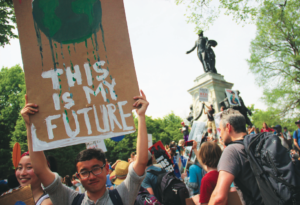Many enjoyed the hot, sunny day on Saturday, April 29, while the People’s Climate March surged in Washington D.C. Held on the hundredth day of President Donald Trump’s presidency, the protest voiced against the Trump administration’s many controversial environmental policies including the defunding of the Environmental Protection Agency (EPA). At the march, thousands gathered to advocate “climate, jobs, and justice.” Many in the Choate community were among them.
The first People’s Climate March was held on September 21, 2014, in New York City, along with a series of sister marches worldwide. The founder of climate advocacy website 350.org, Mr. Bill McKibben, organized the march and started planning the march as early as May 2014 as a response (but not a protest) to the U.N. Climate Summit in New York City. According to Mr. McKibben, the march served as “an invitation to change everything,” and over 1,500 organizations — including both international and national environmental organizations, churches, schools, and communities — and over 600,000 people participated.
This year’s People’s Climate March hosted over 200,000 people in D.C. with tens of thousands more taking part at over 370 sister marches across the country. The participants ranged from students fighting for environmental justice to Iraq veterans supporting a clean environment. The rest included labor activists, indigenous people facing severe ramifications of climate change and harmful legislation such as the reopening of the Dakota Access Pipeline, and children and young people who will live with the effects of climate change as long as the Earth continues to warm. Unlike the march in 2014, this year’s march consisted of protests against specific policies and executive orders enacted by the Trump administration.
The march in D.C. began at sunrise with a water ceremony led by indigenous people, including Cheyenne River Sioux tribal members who traveled 1,536 miles by bus from South Dakota. In the opening press conference, representatives from various communities directly impacted by climate change and pollution voiced their concerns regarding the Trump administration’s actions. They spoke about the potential of new renewable energy economy that could help low-income and people of color communities, who are often the victims of climate change.
The event was led by young people of color and indigenous leaders across the country as they marched for over 20 blocks down Pennsylvania. Art was on full display during the march. Posters read, “Like the Sea Level, We Rise,” “Indigenous Rights = Climate Justice,” and “There Is No Planet B.” Some groups held sunflowers, a symbol of climate justice community, while others raised their fists.
Passionate about social justice and environmental activism, Elsa Rose Farnam ’18 and her parents rented a van to participate in the Climate March in D.C., taking several other Choate students with her. They stayed at a hotel in D.C. the night before the march and attended the march all day the day after. Farnam has been actively involved in environmentalism, attending the People’s Climate March in New York City in 2014 and participating in the Environmental Immersion Program at the Kohler Environmental Center (KEC) this year.
Farnam attended the march to raise awareness of the environmental conflicts surrounding us. “Climate change is an important and serious issue,” Farnam said. “The only way to fix it is getting into the streets, protesting, and acknowledging that it’ll requires a lot of help from various communities to solve it.”
Elise Hummel ’18, another student at the KEC, attended the march in D.C. with Farnam. Hummel attended the march to show the world that climate change is a real issue that affects many people around the world. “The march was very inspiring,” Hummel commented. “It was great to see so many people with the same ideas and values as I do.” Hummel added that she hopes the march shines light on complicated issues surrounding climate change and the urgent need for youth participation.
Grayce Gibbs ’18 felt that the march was an important way to exercise her dedication to environmental issues. Gibbs, who attended with Hummel and Farnam, described, “I went to the march for two main reasons. First, selfishly, I had never been to a protest before, and this sounded like a lot of fun. A van trip to DC to march for the planet was hard to pass up. The other reason I went was because I think taking an active role in your government is incredibly important. I wanted to show the current administration that climate change is not an issue they can ignore.”
Hummel commented, “One of the things said during the march is that young people are not the future; they are the present. It’s up to us to make changes in the world now.”





